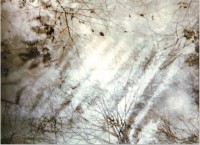December 9, 2015
Many thanks for Edmund Zagorinin’s thrilling review of my new book The Hope of Floating Has Carried Us This Far in the Los Angeles Review:
“Readers will find in Wikswo a voice of startling originality, one that hearkens to the challenges of a Beckett or a Lispector and yet does so in a manner all of her own, fortified with odorous grave-dust and what she refers to as “the ethics of eavesdropping.”
“There is a sense of Bruno Schulz’s demiurgy in Wikswo’s prose, the sense not merely of the bodies, but the trails they left upon the world. Here we find what American Indian scholar Vine Deloria might describe as visionary knowledge, site-specific narrative that defies abstraction and is rooted in the tangible (if fleeting) texture of pure experience.”
“Across the pages of The Hope of Floating Has Carried Us This Far, writer-photographer Quintan Ana Wikswo accomplishes places of uncommon depth via an elixir of language, photography, and negative space. The full effect transports readers to submerged memories, buried places that exist in perpetual correspondence with violence, loss, and solitude: places with names (Vilnius, Pyongyang, The Antilles) and places without names (the shoreline, awakening, whispers). The photographs are mostly illustrations of the latter. Readers will find in Wikswo a voice of startling originality, one that hearkens to the challenges of a Beckett or a Lispector and yet does so in a manner all of her own, fortified with odorous grave-dust and what she refers to as “the ethics of eavesdropping.” What are we to do, then? Says Wikswo: “Give promises that predict a new kind of orifice, something that opens and closes in a part of the body that is currently undiscovered, through which something good emerges.”
Though stories, this book should be treated with the care and gingerness one would show a collection of poems – one at a time, not in one sitting, over a longer horizon of contemplative and spontaneous reading times. But the book is hardly atmospheres alone. Rather, places become the media by which Wikswo corresponds with herself and others, as in “my Nebulae, my Antilles,” where the narrator mails herself letters that arrive months later, arousing the suspicions of her landlady that she has a Caribbean lover. From both the places and images, readers will notice that The Hope is a wet book, a book of shorelines, which is also to say that both the language and the photographs have a kind of thickened wateriness to them, one of oceans and rivers and the twilit reflection of skies thick with foreign leaves.
Taken with antique cameras, Wikswo’s photographs should be read as poems themselves, the vanishing points where Wikswo’s words are busy wandering.

Rumors of massacre. Rumors of prison. Rumors of sons. Somewhere, a war wages against itself. Somewhere, there are mass graves. We are far North and treeswarmed, and otherwise unsure. “I have followed a woman into the wilderness.” And? “Hers was not among the bodies.” There is a sense of Bruno Schulz’s demiurgy in Wikswo’s prose, the sense not merely of the bodies, but the trails they left upon the world. Here we find what American Indian scholar Vine Deloria might describe as visionary knowledge, site-specific narrative that defies abstraction and is rooted in the tangible (if fleeting) texture of pure experience. About her methodology, Wikswo writes: “A coast is a site where sea meets shore, and both are transformed by the encounter. The creation of this book occurred over many thousands of miles of coastline in the Baltic, New York, and California. There were many seas and many shores, and I am grateful for the many ineffable transmutations along the way.” Read this book for its ineffable transmutations and you will find yourself embarrassed by their richness.
